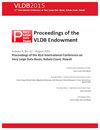MagicScaler: Uncertainty-Aware, Predictive Autoscaling
IF 3.3
3区 计算机科学
Q2 COMPUTER SCIENCE, INFORMATION SYSTEMS
引用次数: 1
Abstract
Predictive autoscaling is a key enabler for optimizing cloud resource allocation in Alibaba Cloud's computing platforms, which dynamically adjust the Elastic Compute Service (ECS) instances based on predicted user demands to ensure Quality of Service (QoS). However, user demands in the cloud are often highly complex, with high uncertainty and scale-sensitive temporal dependencies, thus posing great challenges for accurate prediction of future demands. These in turn make autoscaling challenging---autoscaling needs to properly account for demand uncertainty while maintaining a reasonable trade-off between two contradictory factors, i.e., low instance running costs vs. low QoS violation risks. To address the above challenges, we propose a novel predictive autoscaling framework MagicScaler , consisting of a Multi-scale attentive Gaussian process based predictor and an uncertainty-aware scaler. First, the predictor carefully bridges the best of two successful prediction methodologies---multi-scale attention mechanisms, which are good at capturing complex, multi-scale features, and stochastic process regression, which can quantify prediction uncertainty, thus achieving accurate demand prediction with quantified uncertainty. Second, the scaler takes the quantified future demand uncertainty into a judiciously designed loss function with stochastic constraints, enabling flexible trade-off between running costs and QoS violation risks. Extensive experiments on three clusters of Alibaba Cloud in different Chinese cities demonstrate the effectiveness and efficiency of MagicScaler , which outperforms other commonly adopted scalers, thus justifying our design choices.MagicScaler:不确定性意识,预测性自动缩放
预测自动伸缩是阿里云计算平台优化云资源分配的关键,它根据预测的用户需求动态调整弹性计算服务(ECS)实例,以确保服务质量(QoS)。然而,云中的用户需求往往非常复杂,具有高度的不确定性和对规模敏感的时间依赖性,因此对未来需求的准确预测提出了很大的挑战。这些反过来又使自动扩展具有挑战性——自动扩展需要适当地考虑需求的不确定性,同时在两个相互矛盾的因素之间保持合理的权衡,即低实例运行成本与低QoS违反风险。为了解决上述挑战,我们提出了一种新的预测自缩放框架MagicScaler,它由一个基于多尺度关注高斯过程的预测器和一个不确定性感知的缩放器组成。首先,预测者仔细地将两种成功预测方法中的最佳方法——善于捕捉复杂、多尺度特征的多尺度注意机制和量化预测不确定性的随机过程回归结合起来,从而实现具有量化不确定性的准确需求预测。其次,该标量将量化的未来需求不确定性转化为具有随机约束的合理设计的损失函数,实现了运行成本与QoS违规风险之间的灵活权衡。在中国不同城市的三个阿里云集群上进行的大量实验证明了MagicScaler的有效性和效率,它优于其他常用的scaler,从而证明了我们的设计选择是合理的。
本文章由计算机程序翻译,如有差异,请以英文原文为准。
求助全文
约1分钟内获得全文
求助全文
来源期刊

Proceedings of the Vldb Endowment
Computer Science-General Computer Science
CiteScore
7.70
自引率
0.00%
发文量
95
期刊介绍:
The Proceedings of the VLDB (PVLDB) welcomes original research papers on a broad range of research topics related to all aspects of data management, where systems issues play a significant role, such as data management system technology and information management infrastructures, including their very large scale of experimentation, novel architectures, and demanding applications as well as their underpinning theory. The scope of a submission for PVLDB is also described by the subject areas given below. Moreover, the scope of PVLDB is restricted to scientific areas that are covered by the combined expertise on the submission’s topic of the journal’s editorial board. Finally, the submission’s contributions should build on work already published in data management outlets, e.g., PVLDB, VLDBJ, ACM SIGMOD, IEEE ICDE, EDBT, ACM TODS, IEEE TKDE, and go beyond a syntactic citation.
 求助内容:
求助内容: 应助结果提醒方式:
应助结果提醒方式:


